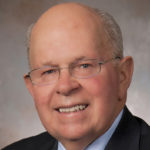Psychotherapy Bulletin
Psychotherapy Bulletin

One of the advantages of serving on the U.S. Senate staff or the APA Board of Directors (especially as President) is that one is systematically exposed to evolving trends within our nation’s healthcare environment and the field of psychology. The position essentially forces one to think creatively beyond personal agendas and previous “comfort” levels. One’s perspective becomes broader and more integrative—similarities across engaged stakeholders become more evident. A review of this year’s Appropriations conference reports, which have been signed into public law, for the Department of Health and Human Services (HHS) and the Department of Veterans Affairs (VA) clearly illustrates an increasing Congressional interest in encouraging the development of a wide-range of mental health services, to be provided by various disciplines, and via evolving technological platforms. More specifically:
- The HHS Behavioral Health Workforce Education and Training account includes support for Master’s level social workers, psychologists, counselors, marriage and family therapists, psychiatric mental health nurse practitioners, occupational therapists, psychology doctoral interns, and behavioral health paraprofessionals. HRSA should continue to encourage all eligible health professions to apply.
- $150,000,000 is provided for the Certified Community Behavioral Health Clinics program under SAMHSA.
- The VA is directed to work with the Office of Personnel Management (OPM) to create an Occupational Series for Licensed Professional Mental Health Counselors and Marriage and Family Therapists and to create a staffing plan to fill such open positions and assess shortages.
- The Secretary of the VA is urged to work with facilities that have not yet implemented VA’s final rule granting full practice authority to advanced practice registered nurses to ensure quick implementation. VA is directed to accelerate the rollout of competitive pay for physician assistants and develop a plan on how to better utilize the Health Professional Scholarship Program and Education Debt Reduction Program.
- Telehealth – HHS: $1,000,000 is included through the Telehealth Network grant program to fund awards that use evidence-based practices that promote school safety and individual health, mental health, and well-being. The grants should provide assessment and referrals for health, mental health, or substance use disorders services to students who may be struggling with behavioral or mental health issues. In addition, grants should provide training and support to teachers, school counselors, administrative staff, school resource officers, and other relevant staffs to identify, refer, and intervene to help students experiencing mental health needs or who are considering harming themselves or others.
- VA: $30,000,000 is provided above the budget request for telehealth capabilities. This additional funding should be used to further expand telehealth capacity and services in rural and remote areas. The VA is directed to provide a report to the Committees on Appropriations of both Houses of Congress specifying measures the Department is taking to expand telehealth and telemental health capacities in rural areas, particularly regions with limited broadband access. The report should also include information on any ongoing collaboration between VA and other Federal agencies to target remote and rural areas to maximize coverage.
“I am very pleased with the extent to which APA has been increasingly active in terms of legislative activities and developing policies that affect, not only psychologists but all citizens of this country. At our March 2018 meeting, the Council of Representatives voted to support pursuing accreditation of Master’s level programs in psychology in areas where APA already accredits. In addition, Council voted to adopt as APA policy the Guidelines on Core Learning Goals for Master’s Degree Graduates in Psychology. A Task Force was formed and has been charged to outline a plan by which APA could pursue development of an accreditation system for Master’s programs in health service areas (clinical, counseling, school, etc.) of psychology.
“On a national level, the APA and the APA Practice Organization government relations staff worked throughout the year with Members of Congress to help shape legislation to address the opioid epidemic. The bill (the ‘SUPPORT for Patients and Communities Act’) passed both the House (by a vote of 393 to 8) and Senate (with a vote of 98 to 1). The SUPPORT Act makes helpful policy changes spanning several federal agencies, including the Centers for Medicare and Medicaid Services and the Department of Health and Human Services.
“Finally, APA has acknowledged that the most effective way to have the maximum impact legislatively is to have ‘One APA,’ a unified advocacy model. In 2017, APA began exploring options for modernizing its structure to create a ‘One APA’ model in which two distinct components (a 501(c3) organization and a 501(c6) organization) seamlessly address the full range of member expectations and the needs of the discipline and profession related to advocacy and member benefits. To guide this transformation, APA committed to maintain, at a minimum, the current budget levels for all advocacy and government relations programs across practice, science, education and public interest. The Work Group recognized the importance of both long-term goals and the need for agility in carrying out the advocacy priorities in a fast-paced political environment. Also critical to the Work Group was that the process emphasizes psychology as a whole, while ensuring that the various sub-fields have a voice and representation in the prioritization process. I am genuinely excited about the future and have decided that the time has arrived, both personally and professionally, for me to run for APA President” [Jennifer Kelly, APA Recording Secretary].
The Global Perspective
In 2002, the World Health Organization (WHO) released its report Prevention and Promotion in Mental Health in which it reiterated that health is: “a state of complete physical, mental and social well-being and not merely the absence of disease or infirmity. Thus, in order to attain health, improvement of the mental health of individuals is essential” (p. 5). The report noted that mental disorders are growing and are responsible for a high degree of burden. “It is essential that effective preventive and promotional measurers be taken in mental health to reduce the impact of mental disorders on the individual and society.” WHO estimated that about 450 million people suffer from mental disorders; one person in every four individuals will be affected at some stage of their life. By 2020, it was estimated that depression will become the second leading cause for disease burden. This burden extends into the community and society as a whole, having far-reaching economic and social consequences.
“Natural or human-made disasters and conflicts generate a huge number of psychosocial and mental health problems that cause enormous strains on society. These conflicts tend to be in the poorest regions of the world and the associated burden of mental health problems leads to severe financial strains on the already impoverished monetary situation in these countries,” There were vast differences between countries in available mental health resources. The concept of what constitutes mental illness varies amongst cultures based on local beliefs and practices. WHO called on professional associations and prevention research groups to become mobilized to undertake research in the development of evidence-based effective strategies, which might well differ across countries and cultures.
More than a decade and a half later, former APA President Alan Kazdin: “There is now a well-documented crisis in mental health in the United States and world-wide. Stated generally, the vast majority of individuals in need of mental health services receive absolutely nothing. Just considering the U.S., we know that approximately 70% of individuals in need of mental health services receive nothing; i.e., no formal treatment of any kind by a health practitioner. In clinical psychology, there is a massive outpouring of evidence-based treatment, quibbles about treatment as usual (often just as effective as evidence-based treatments), what meta-analyses of therapy really show or do not show, why therapy works, can we bridge the research practice gap, and so on. All are arguably important and classic questions. All are arguably missing the point. Most people receive no treatment.
“Among the many problems is the dominant model of treatment delivery. As a profession in clinical practice and graduate training, we are committed primarily, almost exclusively, to one-to-one individual therapy with a trained mental health professional. The professions not only advocate that, they are very interested in protecting that. We have considerable evidence now that lay individuals (heresy to mention but they are not licensed) can administer treatment effectively to treat individuals with mental disorders. And we now have many models of delivery that can reach people in need but are not at all part of training among the mental health professions and do not seem to be of much interest.
“Individual psychotherapies of all kinds, task force reports about the problem, various ‘resolutions’ and consensus statements continue to ignore the problem. What is psychology doing to reduce the burdens of mental illness and to reach people in need of services? I am not implying that we are not doing wonderful things. But treatments, evidence-based or not, just are not getting to people in need. The situation is even worse among subpopulations (individuals of an ethnic minority, children and adolescents, single parents, elderly individuals, victims of domestic violence, and the list goes on). What are we doing to reach people in need and to reduce the burdens of mental illness? The professions could do more. Our effectiveness in addressing each of these can be measured and measurement is our (psychology’s) specialty. Clinical psychology does not seem to show interest in moving away from treatment models that do not reach people. Could we turn some or more of our mental health profession to problems I have outlined here? Our psychotherapy research and debates aside, this is so much it seems like ‘an emperor’s new clothes’ situation. Imagine if we turned our research and clinical turrets to people in need on a scale that not only made a difference to individuals but to the burdens experienced by their families and society at large. Perhaps I am expecting too much from our discipline. Public Health is probably more relevant.”
We recently discussed this seeming “disconnect” between the potential contributions of psychology (and psychiatric mental health nursing) and the documented worldwide need for mental health services, with Dale Smith, Professor of Military Medicine & History at the Uniformed Services University (USU). Dale pointed out that for WHO to issue such a report, international scholars and public health officials had undoubtedly been seriously discussing this situation for at least a decade, if not longer. He asked: Was our collective failure to act a reflection of our lack of political will? That is, do we really know what we should do, but we have consciously decided not to expend the financial, professional, and political capital necessary to successfully engage? Or, in the alternative, is this the type of complex situation where we genuinely do not know how to address such a compelling need? He suggested that if it were the latter, perhaps the next step should be the development of a comprehensive research strategy exploring what efforts have been attempted in the past and why have they not been successful. Significant change always takes time; often more than one would anticipate.
Unique Interprofessional Training Experience
At USU, psychology and nursing graduate students can join with fourth-year medical students in participating in an intensive five-day field training exercise in the mystical country of Pandakar (located in the woods of rural Pennsylvania). “Bushmaster gave us a unique opportunity to hone our skills in a deployed setting in three primary roles. In the Combat Stress Control (CSC) team role, we immersed ourselves in the Pandakar setting and visited each platoon to conduct a Unit Needs Assessment (UNA). This required us to engage with each platoon’s security team, obtain buy-in from their leadership, and build rapport with their unit members to learn how we could best help them. In the Combat and Operational Stress Control (COSC) clinic role, we established an independent clinic in Pandakar and prepared to accept all types of combat stress casualties for treatment or medevac. Finally, in our ‘real world’ Bushmaster role, we engaged countless participants (to include moulage artists, actors, faculty, and military leadership) to build morale with assistance from our mascot, Panda Pauli. As future leaders and providers in mental health, Bushmaster gave us a glimpse into our deployed role that would be impossible in any other educational setting. Not only did it help prepare us for future clinical care, but it also gave us an opportunity to educate other students on the importance of supporting our troops’ mental health and morale needs downrange” [Michelle Binder, Capt., USAF; Psychiatric Mental Health Practitioner graduate student].
Aloha
Cite This Article
DeLeon, P. (2018). The rising tides—Waves of change. Psychotherapy Bulletin, 53(4), 97-101.
References
World Health Organization. (2002). Prevention and promotion in mental health. Retrieved from http://www.who.int/mental_health/media/en/545.pdf





0 Comments